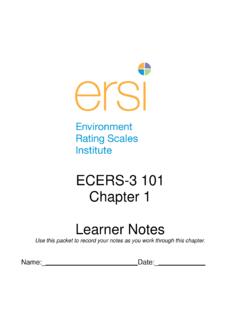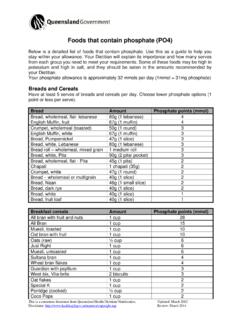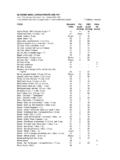Transcription of REDISCOVERY OF THE NEPTUNE’S CUP SPONGE IN ... - TMSI
1 Contributions to Marine Science 2012. Contributions to Marine Science 2012: 49 56. Date of Publication: 29 National University of singapore REDISCOVERY OF THE NEPTUNE'S CUP SPONGE IN singapore : cliona or poterion ? Lim Swee-Cheng Tropical Marine Science Institute, National University of singapore , 18 Kent Ridge Road, singapore 119227. Email: Karenne Tun DHI Water & Environment (S) Pte. Ltd., 1 Cleantech Loop, #03-05 CleanTech One, singapore 637141. Email: Eugene Goh DHI Water & Environment (S) Pte. Ltd., 1 Cleantech Loop, #03-05 CleanTech One, singapore 637141. Email: ABSTRACT. The remarkable Cliona patera, or the famous Neptune's Cup SPONGE , captured the world's imagination two centuries ago with its peculiar morphology and large size. Measuring more than 1 m in height and diameter, the cup-shaped SPONGE was also the first SPONGE species to be described from singapore in 1820.
2 However, the last record of this iconic SPONGE from singapore waters was published in 1908, based on two specimens lodged in the Raffles Museum (collection date unknown). Until recently, Cliona patera was widely regarded as extinct due to overfishing until a single specimen was dredged up from the Gulf of Carpentaria (Australia) in 1990. In this paper, we report its presence from singapore waters, the type locality, once again after more than a century. The generic position of this species in either cliona or poterion is uncertain. There are no records of live characters and little is known about the excavation characteristics of the SPONGE . This study describes C. patera in detail, including in situ observations for the first time. New excavation characters observed under the scanning electron microscope revealed that it is well placed in the genus Cliona, despite its distinct cup-shape and huge size compared to its congeners.
3 KEY WORDS. Neptune's Cup SPONGE ; Cliona patera, singapore , Porifera INTRODUCTION the second British Resident, Crawfurd (1830: 73): . those gigantic sponges , which are peculiar to the coast of Cliona patera (as Spongia patera), the Neptune's Cup singapore , and which Europeans have called Neptunian SPONGE , was the first SPONGE species to be described from cups. The natives brought them to us in great numbers. This singapore (Hardwicke, 1820; Hardwicke, 1822; Low, 2012). remarkable SPONGE continued to fascinate even a hundred It is arguably one of the most iconic and famous SPONGE years after it was discovered, featuring in a popular series of species in the world. It is shaped like a cup or wineglass, W. D. and H. O. Wills Cigarette cards titled Wonders of the growing to over a meter in height and diameter (Fig. 1) Sea (Fig. 3) produced in 1928. However, C. patera was not and sufficiently large for a child to sit inside (Fig.)
4 2). This recorded from singapore waters since the late 19th century. remarkable SPONGE was much sought after by museums and Two specimens were dredged up in singapore waters by the private collectors in the past, and most major natural history Eastern Telegraph Company, probably in the 1870s when museums have at least one specimen of this iconic SPONGE . submarine cables were being laid across singapore Strait The Zoological Museum Amsterdam (ZMA) alone has over to connect Madras and Darwin. These were lodged in the twenty specimens and the Natural History Museum in London Raffles Museum (currently Raffles Museum of Biodiversity has some ten specimens. Research) and reported in Hanitsch (1908). Cliona patera has not been recorded from this region since the early 20th This SPONGE was apparently common and abundant in century. The last record known was off the coast of Bantam singapore waters in the early 19th century.
5 According to in West Java, Indonesia, where two specimens were collected 49. The Neptune's Cup SPONGE in singapore in 1907 (Vosmaer, 1908). Subsequently, there were no records (Hooper & van Soest, pers. comm.). It was only till 1990, of the SPONGE for a long time, leading biologists to speculate that one specimen was dredged up in the Australian waters that the species may likely be extinct due to over-fishing for the first time at the Gulf of Carpentaria (Hooper & Ekins, Fig. 3. Cliona patera featured in a popular series of and Wills Cigarette cards titled Wonders of the Sea produced in 1928. Fig. 1. First drawing of C. patera (as Spongia patera) in Hardwicke (1822) description (the scale bar on the left is in inches). Fig. 2. A child bathing in a gigantic C. patera dried specimen. This photo was taken in Indonesia, possibly in Sumatera, by Van Fig. 4. Cliona patera exhibit in Museo Civico Di Storia Heurn.)
6 This SPONGE is currently lodged in Netherlands Centre for Naturale (Giacomo Doria), Genoa labeled Poterion poseidonis Biodiversity (NCB), Naturalis (RMNH) in Leiden. ( singapore ) . 50. Contributions to Marine Science 2012. pers. comm.). It must be noted that there has been a number TAXONOMY. of SPONGE fauna surveys (Hooper et. al., 2000) in this region but none of these studies recorded C. patera. CLIONAIDAE d'Orbigny, 1851. Two living specimens of C. patera were recently discovered Cliona Grant, 1826. off the southern coast of singapore , the singapore Strait (Tun & Goh, 2011). This is especially amazing as almost the entire Cliona patera (Hardwicke, 1820). southern coastline of singapore and many of the 50-odd (Figs. 5 8). islands in singapore Strait were reclaimed and transformed in the past 50 years (Koninck et. al., 2008). Cliona patera is Material examined. 0272.
7 singapore , singapore iconic but it is also one of the least known SPONGE species. Strait, Kias on 23 March 2011, 12m; 0273. singapore , There were doubts as to whether it should be placed in the singapore Strait, Kias on 18 April 2011, 10m. Studied for comparison: Australia, Gulf genus Cliona (van Soest, pers. comm.; see also Topsent, of Carpentaria, W. of Kirk Reef. 31 November 1991; BMNH. 1909) as it has a unique cup-shaped top or wineglass like Indonesia, Java Sea, off Batavia (now Jakarta). growth form like no other Cliona species. Most Cliona exist Collection date unknown. in the alpha and beta form, only a few exhibits the gamma form and become massive. However, these are amorphous Description. SPONGE in gamma stage and free-living, or irregular in shape, unlike C. patera, which has an upright comprising an oval, shallow, concave disk supported by a stalk with rooting processes extending into the substratum.
8 Stalk with a height of 26 cm (Fig. 5A). The stalk extends A distinct cup forms the main body of the SPONGE and is some 20 cm into substrate after which it branches into 4-6. supported underneath by a stalk. Its excavating ability is rooting processes that extend a further 20 cm in depth into the poorly documented, and only Vosmaer (1908) and Annandale substratum (Fig. 5B). Colour of living SPONGE was white to (1915) reported their observations from dried material. yellow. The upper part of the disk is mostly white, becoming more yellowish towards the exterior and the undersides of A detailed description of C. patera from its type locality the disk and a more intense yellow towards the base of the ( singapore ), together with new in situ and fresh excavation stalk. The consistency of the SPONGE is tough, particularly at characters are described in detail for the first time since the last account by Annandale (1915).
9 The contentious issue of the genus placement of this species is also discussed in the light of these new characters. MATERIAL AND METHODS. Thick sections of freshly collected material were made with a surgical blade, soaked in Xylene-Phenol (1:1) solution before mounting on glass slides in DPX and examined under the light microscope at 100 400 X magnification. Dissociated spicule suspensions were obtained by boiling in concentrated nitric acid (siliceous spicules) and subsequently mounted on brass stubs for examination under a JEOL scanning electron microscope (SEM). Residues of the spicule suspensions were also mounted on glass slides in DPX measurements of spicule dimensions under the light microscope. Spicule size data are given as minimum average maximum based on a minimum of 25 measurements for each spicule type. Images of specimens, sections and SEM preparations were obtained digitally.
10 Systematic and the order of treatment of the families and genera follow the Systema Porifera (Hooper & van Soest, 2002) and the World Porifera Database (van Soest et al., 2012). Fig. 5. Cliona patera. (A) in singapore waters observed in March 2011; (B) Stalk and rooting processes in substratum exposed. 51. The Neptune's Cup SPONGE in singapore the base of the stalk. The oval disk has a diameter of 38 cm tylostyles lying tangentially beneath (Fig. 7B). The cortical on the long side and 28 cm on the short side, with a depth of skeleton is an extension of the tylostyle tracts from the 5 cm. Rim of disk is not level (Fig. 5). Thickness of disk is choanosomal skeleton. In the choanosomal skeleton, vague approximately cm at the rim, becoming gradually thicker pauspicular tracts, loose spicules and collagen surrounded towards the center. Surface of disk is covered with papillae.









